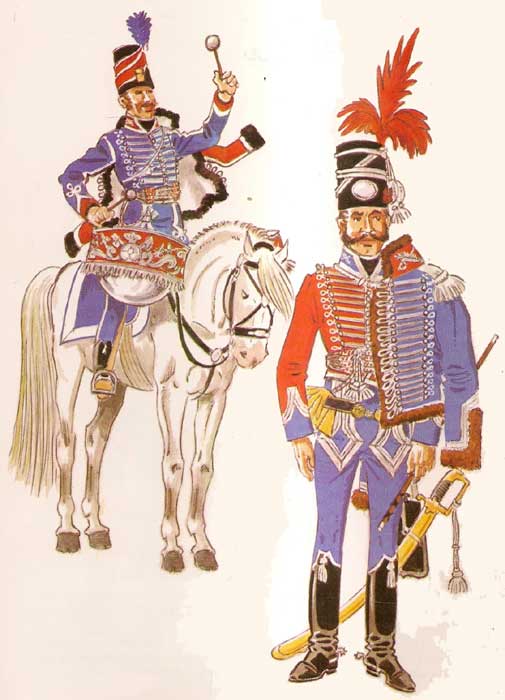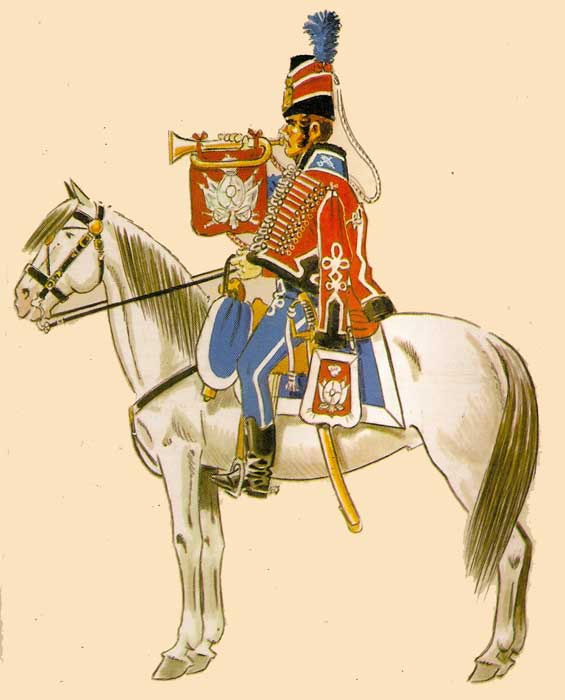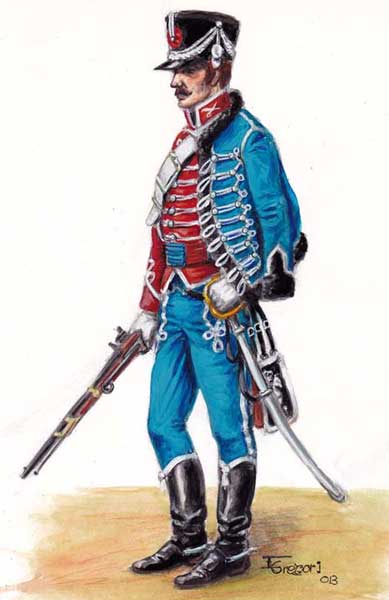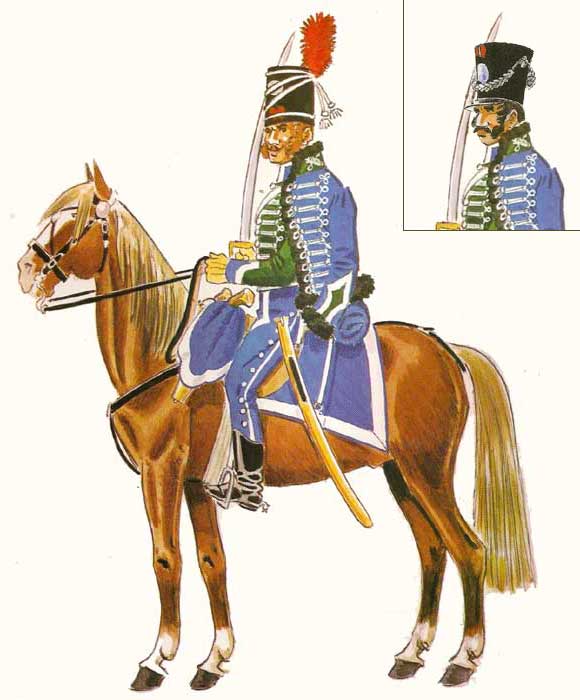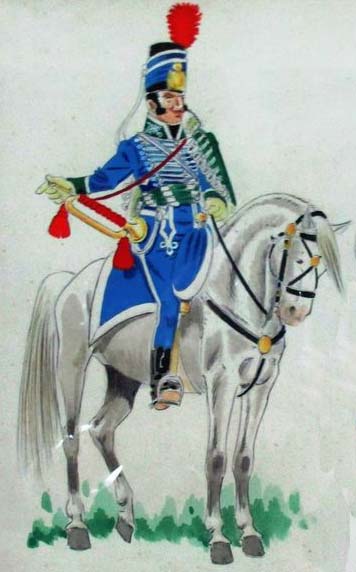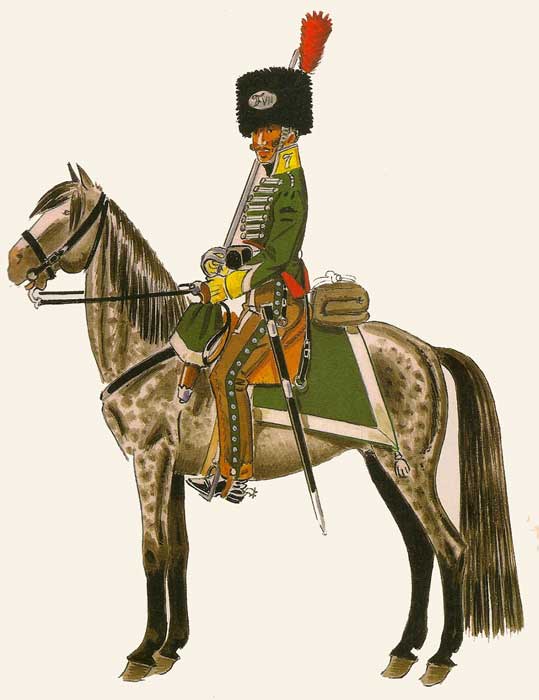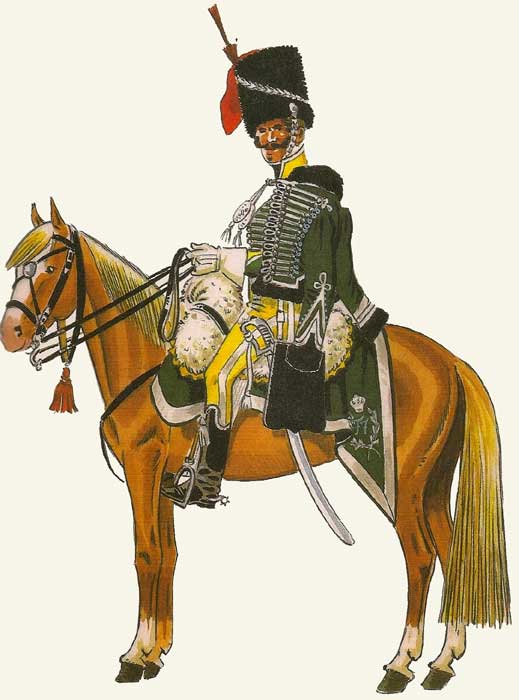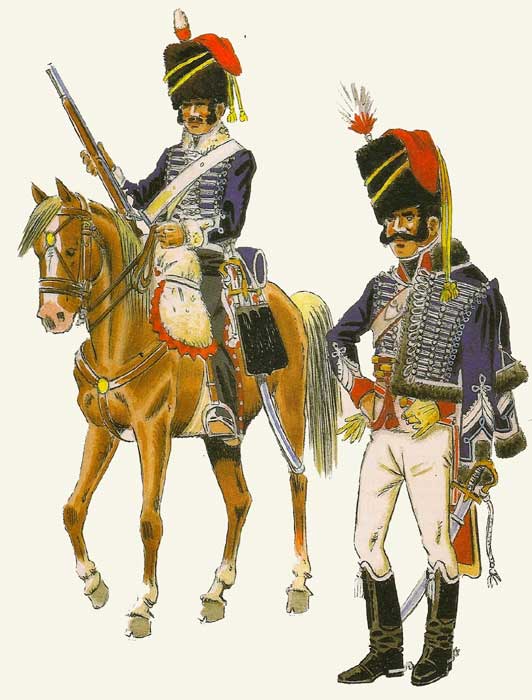|
Spanish Hussar RegimentsHistoryThe first Spanish regiment of hussars, Húsares de Españoles, was created in 1742, but only existed for 7 years, being dissolved in 1749. During the Revolutionary Wars with France, it was determined that Spain did not have enough light cavalry. In 1793 a new light cavalry regiment, the Carabineros de María Luisa, was formed; later renamed the Húsares de María Luisa. Then in 1795 a second new regiment of light cavalry, the Húsares de Españoles, was formed. In 1803, two regiments of Dragoons and two of Cazadores a Caballo were converted to hussars but these reverted to their original role in 1805. So at the start of the Peninsular War there existed two regiments of hussars. Organisation1803 RegulationsFrom 30 January 1803, all cavalry regiments were to have the same organisation, consisting of a regimental staff and 5 squadrons each of two companies. The first four squadrons were field squadrons, the 5th squadron was to be a depot squadron. The regimental staff consisted of:
1 Colonel The regulation stated that there will be no standard-bearers in the Light Cavalry regiments, because these regiments lack standards. This was not entirely true. Previously they had four standards (one per squadron) but from 1803 only one was retained for ceremonial occasions, which was attached to the fifth squadron and was, on such occasions, carried by the oldest Officer Cadet. Although the four field squadrons had no standard-bearers as such, they seem to have retained the 4 Cornets (2nd Lt) on the organization. The regulation also stated that there was to be no kettle-drummer in the hussars, but at least the Húsares de María Luisa seem to have retained theirs! Each company consisted of:
1 Captain The Carabineros were elite troopers selected in for "the best behavior, agility and ruggedness" mounted on the best horses often used as scouts or guides. Men without horses would remain at the depot. Thus the regiment at full establishment should have consisted of 674 men and 544 horses plus officers. At the start of the Peninsular War the regiments had the following strengths:
May 1808The Húsares de María Luisa was used as the base for the creation of the two hussar regiments, the 1º Húsares de Extremadura and the 2º Húsares de Extremadura both at 5 squadrons and 491 men strength. The Húsares Francos de Valencia were created at 3 squadrons and 640 men strength. They were disbanded on 30 June 1811. September 1808The Granaderos de Fernando VII were created at 3 squadrons and 540 men strength. They later became the Húsares de Fernando VII. October 1808From 1 October 1808, all cavalry regiments were to have the same organisation, consisting of a regimental staff and 4 squadrons each of three companies. The staff consisted of 12 officers and 6 men. Each company had 3 officers and 61 men but only 53 horses. Thus a full strength regiment could field at most 654 officers and men, although it is unlikely that the establishment was reached because of the trying times! January 1809From 30 January 1809, each company was to consist of 81 men and 71 horses. May 1809The Húsares de San Narciso were formed, becoming the Húsares de Cataluña on 5 December 1809 at 3 squadrons and 640 men strength. They were merged into the Dragones de Numancia on 1 October 1814. June 1809The Húsares de Granada were created at 3 squadrons and 720 men strength. One squadron formed the Coraceros Españoles in May 1810. In September 1815 the rest of the regiment was incorporated into the Numancia Dragoons. July 1809On 15 July 1809, all cavalry regiments were reduced to 3 squadrons. September 1809The Húsares de Castilla were created at 4 squadrons and 720 men strength. The Húsares de Iberia were created at 4 squadrons and 480 men strength. April 1810The Húsares de Aragon (initially Daroca) were formed at 4 squadrons and 480 men strength. They were absorbed by Húsares de Almansa and Cazadores de Olivenza in April 1813. August 1810The Húsares de Almansa were formed with a strength of 400 troopers. They were disbanded in 1815. January 1811The Húsares de Navarra (initially Corso Terrestre de Navarra) and the Húsares de Galicia were formed. Both had 4 squadrons and 480 men. April 1811On 6 April 1811, the greatly weaken Spanish cavalry was reformed, there were to be only four hussar regiments: Españoles, Granada, Fernando VII and Extremadura. In addition, five provincial hussar squadrons were retained: Cataluña, Aragon, Galicia, Cantabria and Castilla. A regiment of guerrilla hussars, the Húsares de Burgos were also formed based upon the already existing company. In December 1814 they became Cazadores a Caballo. Due to the shortage of horses, two squadrons were to be mounted and one dismounted until such time as enough horses could be found. May 1811The Granaderos de Fernando VII became the Húsares de Fernando VII. Regiments and their UniformsHúsares de María Luisa - Húsares de ExtremaduraThe Carabineros de María Luisa were formed in 1793 and renamed the Húsares de María Luisa by the cavalry regulation of 1803. They fought in the War of the Oranges against Portugal where they earned the scornful nickname "run-away Mary" (Mari huye). On 14 June 1808 they were used to form two regiments, the 1º Húsares de Extremadura and the 2º Húsares de Extremadura. These were later united into a single regiment the Húsares de Extremadura which was one of the four regiments to remain after the 1811 reorganisation and existed until the end of the war. After the war they became the Húsares de Bailén. Uniform: A red dolman with sky blue collar and cuffs. A sky blue pelisse with red collar and cuffs and black fur trim. White braid and lace with white metal buttons. Sabre and palm badge on the collar (standard for all Spanish light cavalry). Sky blue breeches with white lace and piping and Hungarian boots. Red and sky blue barrel sash. Black Mirliton with red wing piped white and red plume above the red Spanish cockade. A sabretache in red bearing the arms of Queen María Luisa was worn in parade dress but probably not on campaign. The same uniform was worn by the Extremadura hussars. The uniform was worn throughout the period, with the exception that the mirliton was replaced by a shako, one source showing them wearing the shako as early as Ocaña on 19 November 1809. They were armed with a curved sabre, two pistols and a carbine. The regulation method was to secure the carbine by a hook to the carbine belt hung over the left shoulder. However it was often hung over the left shoulder by its sling. Sergeants did not carry the carbine. Officer: The same style as that of the trooper but better quality and with silver buttons, lace and braid. Rank insignia was worn above the cuffs, but unusually for hussars even epaulettes in silver were worn. Trumpeter: As was traditional for this period, the trumpeter and the kettle-drummer wore reversed colours with sky blue dolman and red pelisse. Blue plumes were worn. Where possible, they would have ridden greys. Trumpets were brass, and it was common practice to have the regiment's arms on the trumpet banner. The trumpeter's uniform described above follows José María Bueno who in turn was based on Giménez and González. However the regulation of 12 August 1802 stated that the trumpeters of both hussar regiments should have red uniforms (dolman, pelisse, trousers, cloak) with yellow facings (collar and cuffs); I don't know why this doesn't seem to have been followed.
Húsares de EspañolesThe Húsares de Españoles were formed in 1795 and were one of the four regiments still remaining after the 1811 reorganisation. They existed until the end of the war. Uniform: An emerald green dolman with sky blue collar and cuffs. A sky blue pelisse with emerald green collar and cuffs and black fur trim. White braid and lace with white metal buttons. Sabre and palm badge on the collar (standard for all Spanish light cavalry). Sky blue breeches with white lace and piping and Hungarian boots. Sky blue barrel sash. Black Mirliton with green (some sources say sky blue) wing piped white and red plume above the red Spanish cockade. A sabretache was worn in parade dress but probably not on campaign. The uniform was worn throughout the period, with the exception that the mirliton was replaced by a shako. Officer: The same style as that of the trooper but better quality and with silver buttons, lace and braid. Rank insignia was worn above the cuffs, and epaulettes in silver could have been worn by company grade officers. Trumpeter: As was traditional for this period, the 1803 cavalry regulations said that the trumpeter should wear reversed colours. When the Húsares de Españoles received their new uniforms in 1805, this would have been sky blue dolman and emerald green pelisse. The wore a black Mirliton with sky blue wing piped white and red plume above the red Spanish cockade. Where possible, they would have ridden greys. Trumpets were brass, and it was common practice to have the regiment's arms on the trumpet banner.
Granaderos a Caballo de Fernando VII - Húsares de Fernando VIIRaised by Coronel Fernan Nuñez on 15 September 1808 initially as the Regimiento F Nuñezas with 3 squadrons totalling 540 men. They soon became the Horse Grenadiers (Granaderos a Caballo de Fernando VII) and despite what their name might suggest, were light and not heavy cavalry. They were renamed Hussars (Húsares de Fernando VII) on 1 May 1811. They were one of the four regiments to remain after the 1811 reorganisation and existed until the end of the war. 1808-1813Uniform: An emerald green coatee with lemon yellow collar and cuffs and red turnbacks. White braid and lace with white metal buttons. On campaign they wore "Spanish" brown overalls with an emerald green stripe down the outside of each leg and white lace bastion-shape loops on each thigh. Emerald green breeches with white lace and piping could be worn in full-dress. Hungarian boots and a black a colpack (or busby) were worn. Officer: The same style as that of the trooper but better quality and with silver buttons, lace and braid. Trumpeter: No information, bit I presume that the trumpeter wore reversed colours: lemon yellow coatee with emerald green collar and cuffs. Where possible, they would have ridden greys. Trumpets were brass. 1813-1814Uniform: The new uniform was received in March or April 1813, designed by the Prince Regent and shipped from England. An emerald green dolman with lemon yellow collar and cuffs. An emerald green pelisse with black fur trim. White braid and lace with white metal buttons. Lemon yellow breeches with white lace and piping and Hungarian boots. Black a colpack (or busby) with red bag and red plume above the red Spanish cockade. Officer: The same style as that of the trooper but better quality and with silver buttons, lace and braid. Trumpeter: I have no information, but being an English designed uniform, I presume it would follow the English practice and the trumpeter would wear the same uniform as the trooper and not reversed colours. Where possible, they would have ridden greys.
Húsares de AlmansaThe English officer Major-General (in the Spanish service) Whittingham raised the Húsares de Almansa in 1810 with a strength of 400 troopers. The served in Eastern Spain as part of Whittingham's Spanish Division. Uniform: The uniform was shipped from England and was the same as the British 10th Hussars. An dark blue dolman with scarlet collar and cuffs. An dark blue pelisse with white fur trim. Scarlet and yellow barrel sash. White braid and lace with white metal buttons. White breeches and Hungarian boots. Black a colpack (or busby) with red bag, white over red plume and yellow cords. Officer: The same style as that of the trooper but better quality and with silver buttons, lace and braid. Trumpeter: I have no information, but being an English designed uniform, I presume it would follow the English practice and the trumpeter would wear the same uniform as the trooper and not reversed colours. Where possible, they would have ridden greys.
Húsares de BurgosThe successful guerrilla leader, Don Julian Sanchez, formed the Húsares de Burgos in 1809 with the strength of 1 company of 150 men. On 6 April 1811 it was expanded to regiment strength. After the war, in December 1814, it was converted to Cazadores a Caballo. Uniform: A buff dolman with buff collar and cuffs. A blue pelisse with white fur trim. White braid and lace with white metal buttons. Blue breeches with white Hungarian knots and Hungarian boots. Black shako with red pompom above the red Spanish cockade. Officer: The same style as that of the trooper but better quality and with silver epaulettes, buttons, lace and braid. Officers wore a red sash tied to the right. Trumpeter: No information, bit I presume that the trumpeter wore reversed colours: blue dolman with buff pelisse and breeches. Where possible, they would have ridden greys. Trumpets were brass.
FlagsRoyal Decree 1768The Royal Decree 1768 required regiments of cavalry (guard, line, dragons and light) to use standards of damask or velvet in blue, red or white depending on the regiment, with the royal arms embroidered on the obverse, and the regiment's arms on the reverse. In the 4 corners, the fleurs-de-lys must be embroidered in gold or silver. Cravats for all banners and flags should be of red colour, this being the national colour. The finials and fringes were to be gold or silver depending on the regiment. This decree remained in force until 1833 although it was modified by that of 1803 which said that the light cavalry would not carry standards in the field, one standard being retained at the depot for ceremonial occasions. Húsares de EspañolesReconstructions of a possible standard for the Húsares de Españoles. Note that just in the case of the Húsares de Españoles the placement of the royal arms and the regimental arms have been both reversed and rotated 90 degrees (possibly so that they appear correct when they arms appear correct when the standard falls naturally). This does not appear to be the case for the Húsares de María Luisa who had a yellow standard with the arms placed as per the decree.
Sources
|



